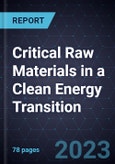Innovations in Recycling, Mining, Refining, and Substituting Materials Spark New Local Supply Chains
Critical raw materials (CRMs) are raw materials that are economically and strategically important for a country or region but have high risks associated with their supply. Criticality depends on various factors, and what counts as critical from a particular standpoint might not be the same from another standpoint. For instance, what might be critical for a solar panel might not be critical for a battery, and what might be considered critical for a particular country might not be critical for another, depending on the available resources and geopolitical scenarios.
This study examines recycling, substituting, and innovating in the mining and refining of particular CRMs that are key for the clean energy transition. Specifically, this study covers cobalt, lithium, copper, nickel, neodymium and dysprosium (the 2 most relevant rare earth materials), and manganese, looking at the ways they can be recovered from motors and generators, solar panels, transmission lines, and hydrogen electrolyzers.
The research describes different challenges involved with each of these materials, from both a mining and geopolitical and supply chain perspective. The analysis also looks at important regulations and policies, such as the European Union's Critical Raw Materials Act, the United States' Federal Strategy on Critical Minerals, and Canada's Critical Minerals Strategy.
Other areas covered in this research include established and emerging recycling methods for batteries, established and emerging recycling methods for rare earth elements, substitution potential in CRMs, and innovations in CRM mining and refining. Companies excelling in any of these areas are profiled. The study concludes with a discussion of the top growth opportunities in this space.








